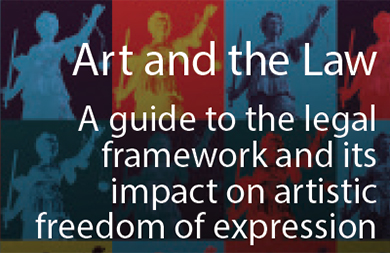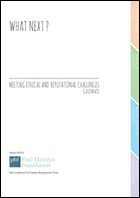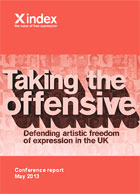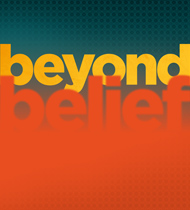29 Sep 2015 | Art and the Law Commentary, Artistic Freedom Commentary and Reports, mobile, News and features, United Kingdom
The following was presented at No Boundaries: A Symposium on the Role of Arts and Culture. Video of Julia Farrington and the day’s other speakers is available on the No Boundaries site.
In 1972, Michael Scammell, the first editor of Index on Censorship magazine, wrote in the launch issue: “Freedom of expression is not self-perpetuating but needs to be maintained by the constant vigilance of those who care about it.”
We obviously haven’t been very vigilant here in the UK.
As we heard last week, when the artist Mimsy’s work Isis Threaten Sylvania was removed from the Passion for Freedom exhibition at the Mall Galleries, London, artistic freedom of expression was put up for sale at £36,000.
And disturbing though it is, the news is a gift to those who have been concerned about the direction policing of politically or socially challenging art was taking. Now the situation is crystal clear and marks an alarming new approach to the policing of controversial art.
In last week’s case, the police were concerned about the “potentially inflammatory content” of Mimsy’s work, so they gave the organisers a classic Hobson’s Choice: if they went ahead with their plans to display it, they would have to pay the police £36,000 to cover the cost of security for the six-day show.
The police took the view that a perfectly legal piece of art, which had already been displayed without incident earlier in the year, was inflammatory. And in the balance of things as they stand, this opinion outweighs the right of the artist to express him or herself, the organisation’s right to present provocative political art, the audience to view it and those that protest against it, the right to say how much they hate it.
If this goes unchallenged, it will set a very dangerous precedent for foreclosing any work that the police don’t approve of.
But going against police advice is tough. In Index’s information pack on Public Order – part of a series of booklets looking at laws that impact on what is sayable in the arts, we ask the question: “What happens if police advise you not to continue with presenting a piece of work because they have unspecified concerns about public safety – and yet tell you it is your choice and they can only advise you?”
The answer is that in principle, in law, you are free to proceed.
But it goes on to talk about duties the organisation has to their employees and members of the public present on their premises, which fall under licencing and other obligations.
But the point is no one has taken this to the courts, so it hasn’t been tried and tested.
As it stands — and in the heat of a crisis when these decisions are mostly reached — police advice is a Hobson’s Choice in pretty much every case.
This latest example of policing comes hot foot after revelations in the summer that the police were involved in, though allegedly not directly responsible for, the cancellation of Homegrown.
And it is only a year since Exhibit B at the Vaults in London and the Israeli hip-hop opera The City in Edinburgh were cancelled on the advice of the police following protests outside both venues.
Way back in 2004 the theatre world was shocked when protest led to the closure of Gurpreet Kaur Bhatti’s play – Behzti following police advice. Gurpreet says that what shocked her most at the time, was how the politicians didn’t take the closure as an opportunity to challenge the police decision, defend her right, and promote the importance of freedom of expression.
Six years later, the Coventry police wanted £10,000 per night to guarantee the safety of the premier production of Gurpreet’s subsequent play Behud at the Belgrade Theatre, which was her creative response to having her play cancelled in Birmingham; and which, because of the playwright’s history of attracting controversy, was treated by the police as a public order issue from day one of the production.
When faced with the police’s bill, Hamish Glen, artistic director of the Belgrade wrote to the police and said it was a fiscal impossibility for the theatre to pay up, and would amount to de facto censorship of Gurpreet’s voice for a second time. They came back asking for £5,000 per night instead which got the same response from Hamish – and finally they waived the fee and the show went ahead without incident.
In investigating this for a case study I wrote, I asked how the police had come up with the figure, and the answer was that it was assessed by the same criteria for special police services at a football match or a music festival. There is no guidance on policing a not-for-profit arts organisation dealing with fundamental rights – it is not on the police radar.
Writing a case study on the policing of the picketing of Exhibit B by Boycott the Human Zoo earlier this year also gave a series of interesting insights
Only one police officer from British Transport Police – The Vaults are under Waterloo Station and therefore under BTP jurisdiction – and two Community Police Officers attended the demonstration of 200 people – so it was obviously not considered a priority, despite the fact that social and print media made it clear that the production was very divisive and both the Boycott and the Barbican had talked to the police.
When, as the protest escalated and extra police arrived, the officer who took charge, talked to Sara Myers, the organiser of the Boycott, asking what was going on – they seemed not to know anything about it. He asked Sara what she wanted. She said she wanted the Barbican to close the show, and she told him that they intended to picket each of the five performances if they did not. The officer’s response was this is much ado about nothing – we haven’t got the resources to police this – we have to be out fighting serious crime.
So The Heckler’s Veto was seen to be working in London and in Edinburgh, just as it had worked in Birmingham ten years previously. When faced with a noisy demonstration, the police showed that they would take the path of least resistance and advise closure of whatever was provoking the protest.
And now a year later, with the removal of Isis Threaten Sylvania, we have seen a shift from the police advising closure following protest, to the police contributing indirectly or directly to the decision to remove work to avoid protest.
This is pre-emptive censorship by the police and represents a major shift in policing and is a clear infringement of civil liberties. It threatens the arts as a space for public debate about the politics of the world we live in.
Though of course because of the paradox of censorship, it actually has the opposite effect, it has amplified the work and many, many more people will be talking about that work because of the police’s move to close it. That doesn’t lessen the sting of the police’s new boldness and the trajectory they seem to be on with this latest act of censorship.
But let’s look at it from the police’s point of view. They are facing massive cuts themselves. George Osbourne’s latest figures indicate at the lowest end – a 25% cut on top of previous rounds. There are fewer police officers on the streets than at any time since the 1970s.
There is no guidance about policing of artistic freedom of expression, compared to pages of guidance on managing protest which stresses on every page the right to protest. When it comes to artistic cases it is left to professional judgement. I have spoken to several senior police officers about this and they will admit that mistakes have been made, but there have never been any consequences for these mistakes, so they remain quite blithe about them. And the bottom line with the police is always public safety.
They also, I believe, feel they have jurisdiction over certain volatile and socially sensitive areas of society where they have duties to prevent crime and to maintain law and order and have community cohesion responsibilities. So when artists venture into this territory with work that may cause offence, their reaction is to simply remove the provocation.
We also now have elected police commissioners who have political agendas – where inevitably policing unpopular, minority voices is going to come low on their agenda – however brilliant they may be, or however important they might be to the fundamental tenets of a liberal democracy.
And this has never been challenged. There has never been any judicial review of the policing of artistic freedom of expression. Judicial Review is the recourse that any arts organisation has when faced with what they consider to be inadequate or unfair policing. Actions by the police are subject to review by the courts for a number of reasons, including for instance if the police failed to consider alternatives to closure, or Article 10 rights generally.
We can and should expect more of the police. Tamsin Allen – senior partner at Bindmans states in an article she wrote for the case study of Behud: “The police have an obligation to fulfil their core duties – those are now enhanced by their duties under the Human Rights Act not to act incompatibly with the European Convention on Human Rights. The convention imposes both a qualified obligation not to interfere with the exercise of the right to freedom of expression and protest and a positive obligation to take appropriate steps to protect those rights. This may change if the Human Rights Act is abolished.”
And we are talking here about legal expression. We do not see artists going to court in the UK – the last major case in this country was Lady Chatterly in the 60s; the Oz Trial, the publishers of the poem The Love That Dares to Speak its Name in the 70s; and the lesser known case of the Human Earrings in 1989, being amongst the very few other cases.
It is also worth pointing out what is obvious – that nearly all the artworks that have been foreclosed by the police over the past few years deal with race and or religion and, Exhibit B notwithstanding, the majority of contemporary cases of contested art are by artists from black and ethnic minorities. This only emphasises the fact that freedom of expression is a biased affair in the UK and I believe will remain so while our society and our culture are not equal.
Acknowledging that, I would add to what Michael Scammell said – the space for freedom of expression has to be more than just maintained – it has to be enlarged and extended.
And as an urgent part of that, we have to challenge this culture of policing, this policing of culture.
The climate is not set fair for promoting the importance of artistic freedom of expression – the political climate is set against human rights. Policing as we have seen with absolute clarity this week in the case of Mimsy’s work, is subject to the prevailing laissez faire of the market place.
In late 2013, I asked Keir Starmer, former director of public prosecutions at the Crown Prosecution Service, if he felt there was a need for police guidance in the area of art and offence and he said emphatically yes. He said he thought it was going to be an increasingly major policing issue over the coming years. He was right.
We have to open up discussion at the highest level with police and the prosecution service, if we are to safeguard the space for freedom of expression in the arts, especially where it relates to political art. The climate might not be conducive, but it has not been tried before, systematically – it is uncharted – let’s go there.
12 Aug 2013 | News and features
Writer and broadcaster Kenan Malik and art historian and educator Nada Shabout on one of the art world’s most contentious debates

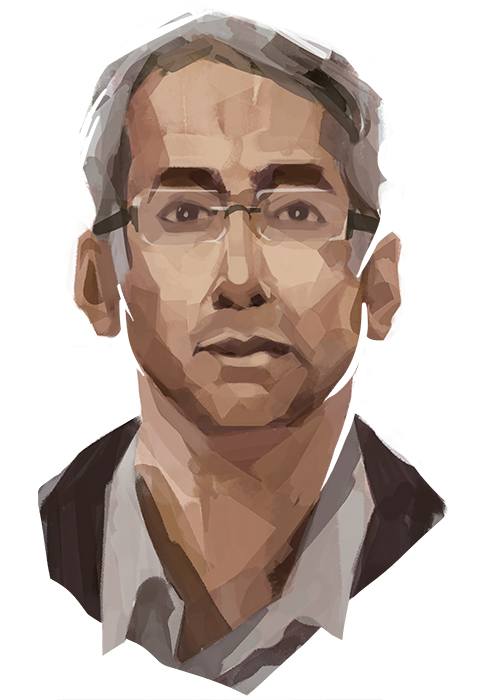
Mark Boardman/www.mark-boardman.com
Dear Nada,
I regard free speech as a fundamental good, the fullest extension of which is necessary for democratic life and for the development of other liberties. Others view speech as a luxury rather than as a necessity, or at least as merely one right among others, and not a particularly important one. Speech from this perspective needs to be restrained not as an exception but as the norm.
The answer to whether religious and cultural sensibilities should ever limit free expression depends upon which of these ways we think of free speech. For those, like me, who look upon free speech as a fundamental good, no degree of cultural or religious discomfort can be reason for censorship. There is no free speech without the ability to offendreligious and cultural sensibilities.
For those for whom free speech is more a luxury than a necessity, censorship is a vital tool in maintaining social peace and order. Perhaps the key argument made in defence of the idea of censorship to protect cultural and religious sensibilities is that speech must necessarily be less free in a plural society. In such a society, so the argument runs, we need to police public discourse about different cultures and beliefs both to minimise friction and to protect the dignity of individuals, particularly from minority communities. As the sociologist Tariq Modood has put it, “if people are to occupy the same political space without conflict, they mutually have to limit the extent to which they subject each others’ fundamental beliefs to criticism”.
I take the opposite view. It is precisely because we do live in a plural society that we need the fullest extension possible of free speech. In such societies it is both inevitable and important that people offend the sensibilities of others. Inevitable, because where different beliefs are deeply held, clashes are unavoidable. And they should be openly resolved, rather than suppressed in the name of “respect” or “tolerance”.
But more than this: the giving of offence is not just inevitable, but also important. Any kind of social change or social progress means offending some deeply-held sensibilities. Or to put it another way: “You can’t say that!” is all too often the response of those in power to having their power challenged. The notion that it is wrong to offend cultural or religious sensibilities suggests that certain beliefs are so important that they should be put beyond the possibility of being insulted or caricatured or even questioned. The importance of the principle of free speech is precisely that it provides a permanent challenge to the idea that some questions are beyond contention, and hence acts as a permanent challenge to authority. The right to “subject each others’ fundamental beliefs to criticism” is the bedrock of an open, diverse society, and the basis of promoting justice and liberties in such societies. Once we give up such a right we constrain our ability to challenge those in power, and therefore to challenge injustice.
The question we should ask ourselves, therefore, is not “should religious and cultural sensibilities ever limit free expression?” It is, rather, “should we ever allow religious and cultural sensibilities to limit our ability to challenge power and authority?”
Best wishes,
Kenan
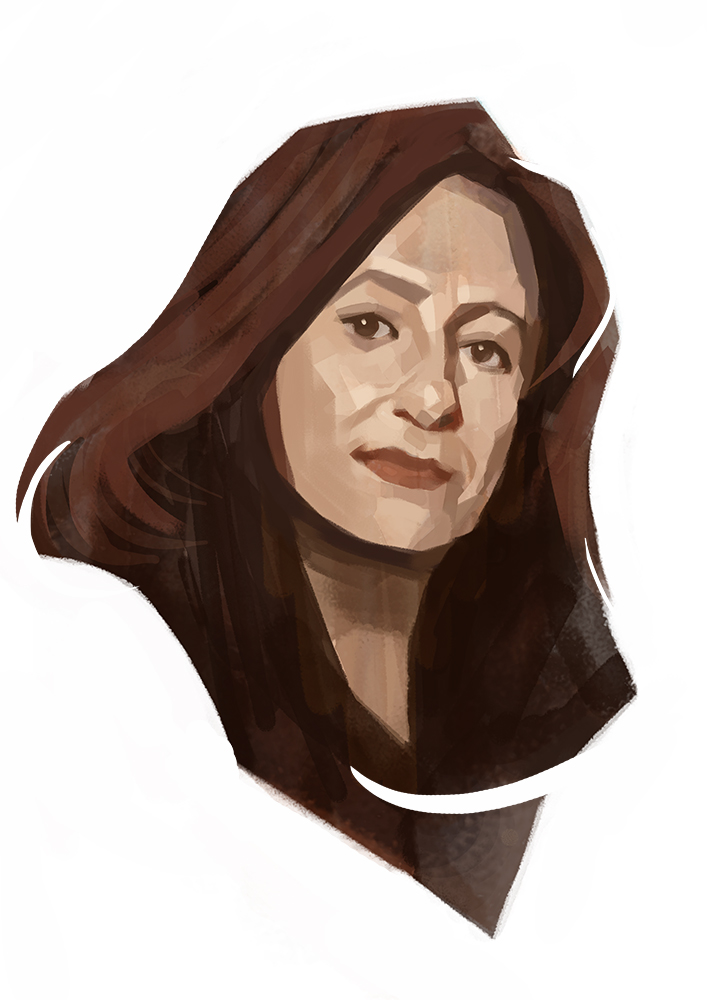
Mark Boardman/www.mark-boardman.com
Dear Kenan,
I too regard free speech as a fundamental good and as necessary. On the surface, thus, the simple and direct answer to the question of whether religious and cultural sensibilities should ever limit free expression should be an unequivocal NO! However, the reality is that the question itself is problematic. While free expression, and let’s think of art in this specific case, will always push the limits and “reveal the hidden”, consideration and sensitivity, including religious and cultural sensibility, should not be inherently in opposition. By positioning it as such, the answer can only be reactive. I thus disagree with your argument.
A quick note on “censorship”. Yes, we all hate the word and find it very offensive. It is a word loaded with oppression, but the reality is that censorship in some form exists in every facet of life, personal and public. It is not that one needs to restrict speech in a plural society but that this plurality needs to find a peaceful way of co-existing with respect and acceptance, as much as possible — not tolerance; I personally abhor the word tolerance and find that it generally masks hatred and disdain. No belief is above criticism and nothing should limit our ability to challenge power and authority.
I suppose one needs to decide first the point of this criticism/free expression. Does it have a specific message or reason, and how best to deliver it — or is it simply someone’s personal free expression in the absolute? And if it is someone’s right to free expression, then why is it privileged above someone else’s right — religious and cultural sensibility being someone’s right to expression as well?
For example, and I will use art again, there is a problem when art/the artist is privileged as “genius”, with rights above other citizens — except not really, since the artist is subject to other limitations that may not be religious or cultural, like those of the tradition of expression, funding, law and so on. This is not to say that a religion should dictate expression. We should remember, though, that the marvel of what we call Islamic art was achieved within full respect of Islamic religious sensibilities, but also pushed the limits and critiqued simplicity in interpreting these sensibilities.
Perhaps my view here is less idealistic and more practical, but I see many unnecessary attacks on all sides that do not accomplish anything other than insult and inflame. All I’m saying is that expression is always achieved through negotiations, including limitations.
All the best,
Nada
Dear Nada,
I’m afraid that I was no clearer at the end of your letter than I was at the beginning about your actual stance on free speech. You say you ‘regard free speech as a fundamental good’ and that the answer to “whether religious and cultural sensibilities should ever limit free expression should be an unequivocal NO!” You then, however, go on seemingly to qualify that unequivocal stance but without actually specifying what it is that you wish to qualify. Where should the line be drawn when it comes to the issue of what is and is not legitimate free speech? Who should draw that line? And on what basis? These are the critical questions that need answering. You write: “It is not that one needs to restrict speech in a plural society but that this plurality needs to find a peaceful way of co-existing with respect and acceptance”. It’s a wonderful sentiment, but what does it actually mean in practice? Should Salman Rushdie not have written The Satanic Verses so that he could find “a peaceful way of coexisting with respect and acceptance”? Was the Birmingham Rep right to drop Gurpreet Kaur Bhatti’s play Behzti after protests from Sikhs? Should Jerry Springer: The Opera ever have been staged (or broadcast)?
You suggest that “one needs to decide first the point of this criticism/free expression. Does it have a specific message or reason, and how best to deliver it — or is it simply someone’s personal free expression in the absolute?” Again, I am unclear as to the point you’re making here. Are you suggesting here that speech is only legitimate if it has “a specific message or reason”? If so,who decides whether it does? During the controversy over The Satanic Verses, the philosopher Shabbir Akhtar distinguished between “sound historical criticism” and “scurrilously imaginative writing”, and insisted that Rushdie’s novel fell on the wrong side of the line. Do you agree with him? If not, why not? You ask: “If it is someone’s right to free expression, then why is it privileged above someone else’s right — religious and cultural sensibility being someone’s right to expression as well?” This seems to me a meaningless question. A “sensibility” is not a “right”, still less a “right to expression”. If your point is that all people, whatever their religious or cultural beliefs, should have the right to express those beliefs, then I agree with you. That is the core of my argument. What they do not have is the “right” to prevent anybody expressing their views because those views might offend their “sensibilities”.
A final point: to defend the right of X to speak as he or she wishes is not the same as defending the wisdom of X using speech in a particular fashion, still less the same as defending the content of his or her speech. Take, for instance, The Innocence of Muslims, the risibly crude and bigoted anti-Muslim video that provoked so much controversy and violence last year. I would defend the right of such a film to be made. But I would also question the wisdom of making it, and would strongly challenge the sentiments expressed in it. There is a distinction to be drawn, in other words, between the right to something and the wisdom of exercising that right in particular ways. It is a distinction that critics of free speech too often fail to understand.
Best,
Kenan
Dear Kenan,
Nicely said! I believe we are ultimately saying the same thing. It is that “distinction” that you outline in your last paragraph that I call a negotiation between all sides, cultures, etc. My answer is not clear because the issue is not simple! I am saying that it is not a black and white binary divide nor can one “draw a line”. And yes, “who should draw that line? and on what basis?” is critical and essential. I believe that should be reached through negotiation. The “wisdom” of something to exist is as important as its right to exist. But there is also the question of responsibility. Free speech cannot be “inherently good” or bad. The person who utters that speech must claim responsibility for its use and effects. The examples you cite above are not all equal. Yes, they all have the right to exist. But let’s think a bit about the Danish cartoons about the Prophet Mohammed as another example. Were they not an attack aimed to inflame Muslim communities? Was it not part of Islamophobia?
Was the aim not to ridicule and play off people’s fears and prejudices? How were they a critique of Islam? What was the point? It is not that “it is morally unacceptable to cause offence to other cultures” as you once said, but the how and why are just as important as the right to cause that offence. I agree with you that the fear of consequences has become a limitation, but that isperhaps because free speech has been abused.
Perhaps I am looking at this from a different point of view. As an educator, I often face the situation, equally here in the US and in the Middle East, of how to argue a point that has become of specific cultural/religious/political sensitivity to my students. If I offend them here, they will stop listening; in the Middle East, I will not be allowed to continue. What would I gain by doing that? By negotiation I test the limits and push gently. At least in academia, I think we are at a point where we have to teach our students to not get offended by an opposing opinion and to be able to accept various opinions and to be able to accept criticism. I don’t think I can achieve that through shock alone!
Best, Nada
Dear Nada
You write that your “answer is not clear because the issue is not simple”. Perhaps. But surely, if the answer is not simple, that only places a greater imperative to make one’s answers as clear as possible?
You believe that we are “ultimately saying the same thing”. I am not so sure that we are. So, let us try to work out where we do agree and where we don’t.
There are two questions we are debating. The first is about the legal limits to free speech. My view is that the law should not in any way protect cultural or religious sensibilities. All speech should be legal except where it directly incites violence. I assume that is your position, though you have never actually stated it as such. Do we agree on that?
The second question is about how we can define speech that is legally acceptable but morally distasteful. You say that where we draw the moral line “should be reached through negotiation”. But negotiation with whom? And on what basis?
You raise a series of questions about the Danish cartoons, and imply that the cartoons were not legitimate speech but created merely to provoke, and hence should not have been published. You don’t, however, actually say that. So, to clarify, is that your view?
Exactly the same questions were, as I pointed out in an earlier letter, asked about The Satanic Verses, and many came to the same conclusions about Rushdie’s novel: that it was Islamophobic, designed to provoke and inflame Muslim communities, that it ridiculed Islam and played off people’s fears, and so on. The philosopher Shabbir Akhtar described it as an “inferior piece of hate literature”. The liberal Ziauddin Sardar wrote that reading the novel felt like being “raped”. The novelist Rana Kabani insisted that it played upon ancient Islamophobic stereotypes.
In the case of both The Satanic Verses and the Danish cartoons, the majority of Muslims, certainly initially, stayed indifferent to the issue. A vocal minority transformed both into global controversies. So, what does “negotiation” mean in this context? Muslim objection to The Satanic Verses was as deep and as broad as that to the Danish cartoons. Yet, you seem to think that it was right to publish the novel but not the cartoons. Why? And please don’t say “My answer can’t be clear because the issue is not simple”.
In any case, the questions that you raise — Is it Islamophobic? Is the aim merely to ridicule? etc — are different from the question that we are actually addressing: “Should religious or cultural sensibilities ever limit free speech?”. There is, in my view, a moral imperative on free speech advocates to challenge racist and other bigoted speech. I certainly do not that think that about speech that offends cultural or religious sensibilities. On the contrary, the moral imperative is often to transgress such boundaries. It is the conflation of racism and bigotry, on the one hand, and of cultural and religious sensibilities, on the other, that is the problem. Opponents of free speech often conflate these two issues in an attempt to establish a spurious legitimacy for their arguments against the giving of offence.
Best wishes,
Kenan
Kenan Malik is a writer and broadcaster. His latest book is From Fatwa to Jihad: The Rushdie Affair and its Legacy (Atlantic Books)
Nada Shabout is associate professor of art education and art history at the University of North Texas and director of the Contemporary Arab and Muslim Cultural Studies Institute
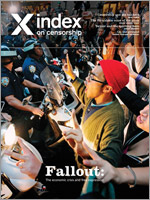
5 May 2010 | News and features
An unpublicised reading of the cancelled Sikh play proved excuses for its continued censorship have been demolished argues Robert Sharp

This is a cross-post with liberty central
Last Friday, British theatre took a small step in the direction of free speech. At the Soho Theatre, in the heart of London’s west end, Gurpreet Kaur Bhatti’s Behzti was performed in the UK for the first time since it was controversially cancelled in 2004.
Let us be clear: this was no great stride for freedom, more an anxious shuffle. The performance was a rehearsed reading, not a full production, and received no publicity whatsoever. It was completely absent from the theatre’s website, and was only advertised to those who had been to see Behud, Bhatti’s most recent play. Buying a ticket felt a little like purchasing bootleg liquor from under the counter, and the atmosphere in the auditorium was, I imagine, how dissidents must have felt in the 1640s, when religious puritans closed the theatres and drama was performed illegally. Proper free speech has to be more open than this.
However, at the start of the performance, it became clear just how necessary and important this toddler’s step was to those who lived through the panicked, abrupt cancellation of 2004. I was surprised to hear Janet Steel, the director of the original production, say that she “thought this day would never come.” To an outsider, this modest reading was hardly radical. But to those who were threatened, who witnessed the picket lines first-hand, it is as if the cancellation happened yesterday. The first impressive thing about Friday’s reading was how many of the original cast had turned out to revive the script.
The performance revealed just how essential it is to the piece that it is set in a gurdwara. The rapist, Mr Sandhu, has built the temple, and is responsible for extending it. His office is his lair, and he derives his power over the other characters when he is in it. Choose any other setting (as some have suggested) and the key dynamic simply doesn’t work.
Behzti is often referred to as “that Sikh play”, a phrase which suggests a comparison with “The Scottish Play” (indeed, it has a lot in common with Macbeth, including a heightened realism and off-stage murders). This label suggests that it is for the Sikh community alone to determine its worth and relevance. This is a mistake – sexual abuse is, sadly, universal. For example, scenes from Behzti were mirrored in Two Women, which has just finished a run at the Theatre Royal, Stratford East. In that play, too, we see the complicity of women in the perpetuation of the abuse cycle. And we all know that child abuse and even murder within a church setting is a long established theme for drama. Behzti is a visceral play that the British public, all of us, deserves to see.
Six years after its abortive first production, Behzti still feels current and relevant. The actors turned in a robust delivery with very little time to rehearse, as if they were picking up where they left off. They have reinforced the artistic case for a proper revival.
Over the past five and half years, all other barriers to a remount have also crumbled. The blasphemy argument is as incoherent now as it was then. Even in 2004, there was no consensus among Sikh commentators as to whether the play was an insult to the religion. Since then, the very idea that blasphemy is a reason for censorship has been discredited. After Behzti, controversies over the Danish Muhammad cartoons, and the protests surrounding Jerry Springer the Opera have tested the public’s patience on the issue of “offence”. Public opinion is now firmly against censoring art for religious reasons, and it is now broadly accepted that faith remains strong even when religion is criticised. Even the hotheads who might disagree in principle know that, in practice, peaceful protest and counter-speech are more effective than threats. The violent demonstrations outside the Birmingham Rep are a thing of the past.
Moreover, the police have shown unequivocally that they are prepared to guarantee the safety of the theatregoers at controversial performances. For Behud in Coventry, the West Midlands police force took this issue extremely seriously, and allocated their staff accordingly, at no charge to the theatre. They have offered to do the same for future controversial productions.
Most importantly, Bhatti herself is positive about a revival of Behzti. In past years, she was (understandably) reticent about new productions. But on Friday evening she said to me that she “would love to see a new production”.
For too long, the British theatre community has been embarrassed by the Behzti affair. Its response to the crisis was positive but far too slow. Half a decade later, theatre directors can no longer wish the play into obscurity – its continued censorship is a boil that must now be lanced. The only barrier that now remains is the British theatre community itself, which needs to purge itself of the cowardly and ignorant assumption that the play is still “off limits”.
No more of this apathy. Let it be known that, as of last Friday, this excuse of last resort has been demolished. Behzti is no longer taboo. It can be performed, properly and publicly. What are we waiting for?
Robert Sharp is the campaigns manager at English PEN
14 Apr 2010 | Uncategorized
From Behzti to Behud was a day of fascinating discussion looking at the impact of the events surrounding the production of Gurpreet Bhatti’s play Behzti at the Birmingham Rep Theatre in 2004.
That production was cancelled when protests from some Sikhs turned violent. The event was produced by Index on Arts, at The Belgrade Theatre, Coventry, either side of the matinee performance of Behud, Gurpreet Kaur Bhatti’s new play which was inspired by those events in Birmingham. Gurpreet Kaur Bhatti made a rare appearance at the after-show discussion and gave her perspective on the “global brand” that Behzti became. Both discussions were recorded and will be available on line shortly.
Two points in the discussion made a particular impression.
The first returns to the 2004 scenario and the thorny issue of the rights and wrongs of consultation — Birmingham Rep invited members of the Sikh community to view the play before the show opened, which arguably ignited the controversy. Trina Jones from Birmingham maintained throughout the discussion that the theatre had learnt from the mistakes it had maid.
A group of women from Birmingham told the meeting how they felt cheated of the opportunity to see their play Behzti. They deeply regretted that they had not been able to organise a counter-demonstration of women who supported the play and they felt they had failed to make their voice heard at the time.
Another member of the audience pointed out: “Would you consult Catholic priests before putting on a play about sexual abuse in the church? “
The Belgrade learned volumes from what happened in Birmingham. What emerged from the discussion in the morning was the role played by the police in putting on Behud based on the possibility or the fear of it causing offence. We heard from Hamish Glen, artistic director of the theatre, that the police had said the theatre would have to pay thousands of pounds to cover policing and security during the play’s run. In the end the police provided the same levels of policing at no cost, but the theatre had to invest huge amounts of energy and resources to head off the ugly possibility of the cost of policing bill scuppering the production the play. In a financial climate of diminishing resources, will the ability of our theatres to put on controversial plays be determined by the ability to pay policing costs, or enter into lengthy negotiations to demonstrate the rights and wrongs of the situation? Belgrade Theatre, the cast and director of the play Behud all displayed iron will in seeing this play through. But as demonstrated by the recent Moonfleece controversy, there is clearly work to be done to ensure that theatre continues to play its role in reflecting contemporary society, and in influencing, shaping, and interrogating our shared culture.

